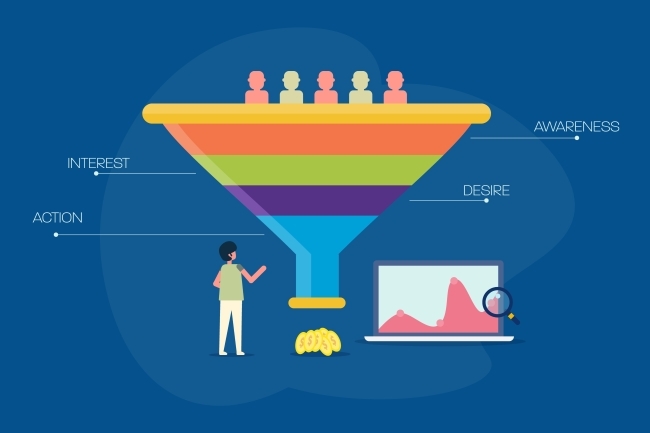How the B2B Insurance Marketing Funnel Is Evolving

Is your marketing funnel leaking? The buying process is evolving, and if your B2B insurance marketing funnel isn’t keeping up, your conversions could suffer. The good news is that it is still possible to reach buyers and move them through the sales process. You just need to find strategies that work now.
What Is the B2B Insurance Marketing Funnel?
The marketing funnel shows the buyer’s journey. At the top of the funnel, you attract interest. In the middle of the funnel, you educate prospects to help them develop a preference for your brand. At the bottom of the funnel, you convert prospects into buyers and foster long-term relationships.
This basic concept is still valid, but how – and perhaps more importantly, where – it happens is changing. In the past, you could control the marketing funnel on your website and social medial media feeds. Now, with the rise of AI and DIY research, much of the process takes place outside of your direct control. This can be scary, but it is still possible to help shape the buyer’s journey.
Why Is the B2B Buyer’s Journey Changing?
You can thank (or blame) AI for the massive disruption taking place now.
Generative AI is changing the way people conduct research. In the past, you might search a phrase on Google, and it would lead you to a company’s website. Or you might search on social media, and it would lead you to a company’s profile, which would lead you to the company’s website.
Now, you can use a chatbot to ask questions, and the AI will summarize your answers. The AI may give links and citations, but you don’t necessarily need to click on anything. If you want to know more, you can just ask the AI a follow-up question.
Google still dominates search, but as AI adoption rapidly grows, the playing field will rapidly evolve. McKinsey & Company says half of consumers use AI-powered search. Bain & Company says 80% of consumers rly on zero-click search results at least 40% of the time. As a result, some companies are seeing their organic traffic plummet.
B2B Buyers Want to Conduct Research on Their Own
The rise of do-it-yourself research is not solely the result of AI. Even before generative AI chatbots came onto the scene, the internet made it easier for people to conduct research on their own. At the same time, many people were bombarded with social media and email ads, causing them to grow increasingly skeptical of any sales pitch. Now, AI makes DIY research even easier. B2B buyers can use AI to get the answers they want without visiting your website or engaging with your sales team.
The 2024 B2B Buyer Experience Report from 6sense found that 81% of B2B buyers had already selected a vendor before talking to a sales rep.
What Does This Mean for the B2B Insurance Marketing Funnel?
If your website isn’t getting views and your sales team isn’t getting leads, you’re probably concerned. The good news is that your buyers may still be there, learning about your company and moving closer toward a purchase. You just can’t see them because they’re relying on AI search and chatbots instead of your website.
So how can you shape the buyer’s journey? The key is to meet buyers where they are.
The New Marketing Funnel
Insurance marketing strategies need to adapt to the new marketing funnel.
- Top of Funnel. In the past, buyers might find your website because they were researching risk management solutions or tech options. Now, there’s a good chance they’ll use AI chatbots, and they may not click on your website. You can still raise awareness of your brand by using Generative Engine Optimization (GEO) tactics to get chatbot mentions. If you offer high-value, well-researched content that answers common questions, and your site is structured in a way that makes it easy for generative AI to understand and access chunks of content, you’re more likely to get AI chatbot mentions, and that will help you increase brand awareness, even if your buyers don’t go to your site immediately.
- Middle of Funnel. You still need to nurture relationships, but this can be harder if B2B buyers aren’t interested in talking to your sales team yet. You can offer high-value gated content, such as in-depth white papers, to entice buyers to share their information. You can also offer DIY-friendly tools like decision trees to help guide buyers without requiring them to contact your sales team. Also focus on your social media strategy, especially LinkedIn, as a way to engage with buyers without directly pushing sales.
- Bottom of Funnel. By the time buyers reach out to you, they may be almost ready to buy, or in the process of comparing you to one or two competitors. You need to instill confidence and differentiate your company. Case studies are a powerful way to move sales to the finish line. Once the prospect becomes a customer, you’ll need ongoing nurturing to keep the relationship strong. A steady stream of blog articles, social media posts and e-newsletters will keep your company top of mind and reinforce the value you deliver.
AI search is still evolving, so the insurance marketing funnel may change again. Whatever happens next, one thing seems fairly certain – B2B buyers need high-quality information they can trust. If you provide content that meets their needs, you can reach them, whether it’s through your website or an AI summary of it.
Inbound Insurance Marketing is your source for insurance-focused content writing and design. Select your insurance marketing subscription.
